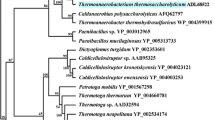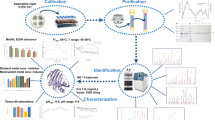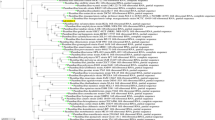Abstract
A xylanase gene, xynE2, was cloned from thermoalkaline Anoxybacillus sp. E2 and was expressed in Escherichia coli BL21 (DE3). The gene consisted of 987 bp and encoded a 328-residue xylanase with a calculated molecular weight of 38.8 kDa. On the basis of amino acid sequence similarities, this enzyme was assigned as a member of glycoside hydrolase family 10. Purified recombinant XynE2 showed maximal activity at pH 7.8 and 65°C, and was thermostable at 60°C. The enzyme was highly active and stable over a broad pH range, showing more than 90% of maximal activity at pH 6.6–pH 8.6 and retaining more than 80% of activity at pH 4.6–pH 12.0, 37°C for 1 h, respectively. These favorable properties make XynE2 a good candidate in the pulp and paper industries. This is the first report on gene cloning, expression and characterization of a xylanase from the genus Anoxybacillus.


Similar content being viewed by others
References
Baba T, Shinke R, Nanmori T (1994) Identification and characterization of clustered genes for thermostable xylan-degrading enzymes, beta-xylosidase and xylanase, of Bacillus stearothermophilus 21. Appl Environ Microbiol 60:2252–2258
Bajpai P (1999) Application of enzymes in the pulp and paper industry. Biotechnol Prog 15:147–157
Beg QK, Kapoor M, Mahajan L, Hoondal GS (2001) Microbial xylanases and their industrial applications: a review. Appl Microbiol Biotechnol 56:326–338
Belduz AO, Dulger S, Demirbag Z (2003) Anoxybacillus gonensis sp. nov., a moderately thermophilic, xylose-utilizing, endospore-forming bacterium. Int J Syst Evol Microbiol 53:1315–1320
Biely P (1985) Microbial xylanolytic systems. Trends Biotechnol 3:286–290
Blanco A, Vidal T, Colom JF, Pastor FI (1995) Purification and properties of xylanase A from alkali-tolerant Bacillus sp. strain BP-23. Appl Environ Microbiol 61:4468–4470
Bradford MM (1976) A rapid and sensitive method for the quantitation of microgram quantities of protein utilizing the principle of protein-dye binding. Anal Biochem 72:248–254
Buchert J, Ranua M, Kantelinen A, Viikari L (1992) The role of two trichoderma reesei xylanases in the bleaching of pine kraft pulp. Appl Microbiol Biotechnol 37:825–829
Christov LP, Myburgh J, O’Neill FH, Van Tonder A, Prior BA (1999) Modification of the carbohydrate composition of sulfite pulp by purified and characterized beta-xylanase and beta-xylosidase of Aureobasidium pullulans. Biotechnol Prog 15:196–200
Colak A, Sisik D, Saglam N, Guner S, Canakci S, Belduz AO (2005) Characterization of a thermoalkalophilic esterase from a novel thermophilic bacterium, Anoxybacillus gonensis G2. Bioresour Technol 96:625–631
Collins T, Gerday C, Feller G (2005) Xylanases, xylanase families and extremophilic xylanases. FEMS Microbiol Rev 29:3–23
De Clerck E, Rodriguez-Diaz M, Vanhoutte T, Heyrman J, Logan NA, De Vos P (2004) Anoxybacillus contaminans sp. nov. and Bacillus gelatini sp. nov., isolated from contaminated gelatin batches. Int J Syst Evol Microbiol 54:941–946
Derekova A, Sjoholm C, Mandeva R, Kambourova M (2007) Anoxybacillus rupiensis sp. Nov., a novel thermophilic bacterium isolated from rupi basin (Bulgaria). Extremophiles 11:577–583
Ertunga NS, Colak A, Belduz AO, Canakci S, Karaoglu H, Sandalli C (2007) Cloning, expression, purification and characterization of fructose-1, 6-bisphosphate aldolase from Anoxybacillus gonensis G2. J Biochem 141:817–825
Feng JX, Karita S, Fujino E, Fujino T, Kimura T, Sakka K, Ohmiya K (2000) Cloning, sequencing, and expression of the gene encoding a cell-bound multi-domain xylanase from Clostridium josui, and characterization of the translated product. Biosci Biotechnol Biochem 64:2614–2624
Fukumura M, Sakka K, Shimada K, Ohmiya K (1995) Nucleotide sequence of the Clostridium stercorarium xynB gene encoding an extremely thermostable xylanase, and characterization of the translated product. Biosci Biotechnol Biochem 59:40–46
Gallardo O, Diaz P, Pastor FI (2003) Characterization of a Paenibacillus cell-associated xylanase with high activity on aryl-xylosides: a new subclass of family 10 xylanases. Appl Microbiol Biotechnol 61:226–233
Gallardo O, Diaz P, Pastor FI (2004) Cloning and characterization of xylanase A from the strain Bacillus sp. BP-7: comparison with alkaline pI-low molecular weight xylanases of family 11. Curr Microbiol 48:276–279
Gat O, Lapidot A, Alchanati I, Regueros C, Shoham Y (1994) Cloning and DNA sequence of the gene coding for Bacillus stearothermophilus T-6 xylanase. Appl Environ Microbiol 60:1889–1896
Georis J, Giannotta F, De Buyl E, Granier B, Frere JM, De Buyl E (2000) Purification and properties of three endo-beta-1, 4-xylanases produced by Streptomyces sp. strain S38 which differ in their ability to enhance the bleaching of kraft pulps. Enzyme Microb Tech 26:178–186
Gilkes NR, Henrissat B, Kilburn DG, Miller RC Jr, Warren RA (1991) Domains in microbial beta-1,4-glycanases: sequence conservation, function, and enzyme families. Microbiol Rev 55:303–315
Henrissat B, Bairoch A (1996) Updating the sequence-based classification of glycosyl hydrolases. Biochem J 316(Pt 2):695–696
Huang J, Wang G, Xiao L (2006) Cloning, sequencing and expression of the xylanase gene from a Bacillus subtilis strain B10 in Escherichia coli. Bioresour Technol 97:802–808
Huang H, Shao N, Wang Y, Luo H, Yang P, Zhou Z, Zhan Z, Yao B (2009) A novel beta-propeller phytase from Pedobacter nyackensis MJ11 CGMCC 2503 with potential as an aquatic feed additive. Appl Microbiol Biotechnol 83:249–259
Jalal A, Rashid N, Rasool N, Akhtar M (2009) Gene cloning and characterization of a xylanase from a newly isolated Bacillus subtilis strain R5. J Biosci Bioeng 107:360–365
Khandeparkar R, Bhosle NB (2007) Application of thermoalkalophilic xylanase from Arthrobacter sp. MTCC 5214 in biobleaching of kraft pulp. Bioresour Technol 98:897–903
Khanongnuch C, Lumyong S, Ooi T, Kinoshita S (1999) A noncellulase producing strain of Bacillus subtilis and its potential use in pulp biobleaching. Biotechnol Lett 21:61–63
Khasin A, Alchanati Shoham Y (1993) Purification and characterization of a thermostable xylanase from Bacillus stearothermophilus T-6. Appl Environ Microbiol 59:1725–1730
Laemmli UK (1970) Cleavage of structural proteins during the assembly of the head of bacteriophage T4. Nature 227:680–685
Lee CC, Wong DW, Robertson GH (2005) Cloning and characterization of the xyn11A gene from Lentinula edodes. Protein J 24:21–26
Levasseur A, Asther M, Record E (2005) Overproduction and charachterization of xylanase B from Aspergillus niger. Can J Microbiol 51:177–183
Li XL, Ljungdahl LG (1994) Cloning, sequencing, and regulation of a xylanase gene from the fungus Aureobasidium pullulans Y-2311-1. Appl Environ Microbiol 60:3160–3166
Li N, Meng K, Wang Y, Shi P, Luo H, Bai Y, Yang P, Yao B (2008a) Cloning, expression, and characterization of a new xylanase with broad temperature adaptability from Streptomyces sp. S9. Appl Microbiol Biotechnol 80:231–240
Li N, Yang P, Wang Y, Luo H, Meng K, Wu N, Fan Y, Yao B (2008b) Cloning, expression, and characterization of protease-resistant xylanase from Streptomyces fradiae var. k11. J Microbiol Biotechnol 18:410–416
Lineweaver H, Burk D (1934) The determination of enzyme dissociation constants. J Am Chem Soc 56:658–666
Liu YG, Whittier RF (1995) Thermal asymmetric interlaced PCR: automatable amplification and sequencing of insert end fragments from P1 and YAC clones for chromosome walking. Genomics 25:674–681
Miller GL (1959) Use of dinitrosalicylic acid reagent for determination of reducing sugar. Anal Chem 31:426–428
Monis PT, Giglio S, Saint CP (2005) Comparison of SYTO9 and SYBR Green I for real-time polymerase chain reaction and investigation of the effect of dye concentration on amplification and DNA melting curve analysis. Anal Biochem 340:24–34
Nakamura S, Wakabayashi K, Nakai R, Aono R, Horikoshi K (1993) Purification and some properties of an alkaline xylanase from alkaliphilic Bacillus sp. strain 41 M–1. Appl Environ Microbiol 59:2311–2316
Ninawe S, Kuhad RC (2006) Bleaching of wheat straw-rich soda pulp with xylanase from a thermoalkalophilic Streptomyces cyaneus SN32. Bioresour Technol 97:2291–2295
Pikuta E, Lysenko A, Chuvilskaya N, Mendrock U, Hippe H, Suzina N, Nikitin D, Osipov G, Laurinavichius K (2000) Anoxybacillus pushchinensis gen. nov., sp. nov., a novel anaerobic, alkaliphilic, moderately thermophilic bacterium from manure, and description of Anoxybacillus flavitherms comb. nov. Int J Syst Evol Microbiol 50(6):2109–2117
Pikuta E, Cleland D, Tang J (2003) Aerobic growth of Anoxybacillus pushchinoensis K1(T): emended descriptions of A. pushchinoensis and the genus Anoxybacillus. Int J Syst Evol Microbiol 53:1561–1562
Polizeli ML, Rizzatti AC, Monti R, Terenzi HF, Jorge JA, Amorim DS (2005) Xylanases from fungi: properties and industrial applications. Appl Microbiol Biotechnol 67:577–591
Prade RA (1996) Xylanases: from biology to biotechnology. Biotechnol Genet Eng Rev 13:101–131
Ragauskas AJ, Poll KM, Cesternino AJ (1994) Effects of xylanase pretreatment procedures on nonchlorine bleaching. Enzyme Microb Tech 16:492–495
Solomon V, Teplitsky A, Shulami S, Zolotnitsky G, Shoham Y, Shoham G (2007) Structure-specificity relationships of an intracellular xylanase from Geobacillus stearothermophilus. Acta Crystallogr D Biol Crystallogr 63:845–859
Tabernero C, Sanchez-Torres J, Perez P, Santamaria RI (1995) Cloning and DNA sequencing of xyaA, a gene encoding an endo-beta-1, 4-xylanase from an alkalophilic Bacillus strain (N137). Appl Environ Microbiol 61:2420–2424
Viikari L, Kantelinen A, Sundquist J, Linko M (1994) Xylanases in bleaching: from an idea to the industry. FEMS Microbiol Rev 13:335–350
Wood PJ, Erfle JD, Teather RM (1988) Use of complex formation between congo red and polysaccharide in detection and assay of polysaccharide hydrolases. Methods Enzymol 160:59–74
Wu S, Liu B, Zhang X (2006) Characterization of a recombinant thermostable xylanase from deep-sea thermophilic Geobacillus sp. MT-1 in East Pacific. Appl Microbiol Biotechnol 72:1210–1216
Yumoto I, Hirota K, Kawahara T, Nodasaka Y, Okuyama H, Matsuyama H, Yokota Y, Nakajima K, Hoshino T (2004) Anoxybacillus voinovskiensis sp. nov., a moderately thermophilic bacterium from a hot spring in kamchatka. Int J Syst Evol Microbiol 54:1239–1242
Zamost BL, Nielsen HK, Starnes RL (1991) Thermostable enzymes for industrial applications. J Ind Microbiol Biotechnol 8:71–81
Zhao J, Li X, Qu Y (2006) Application of enzymes in producing bleached pulp from wheat straw. Bioresour Technol 97:1470–1476
Acknowledgment
This work was supported by the National High Technology Research and Development Program of China (863 Program; grant no. 2007AA100601) and the National Key Technology Program of China (grant no. 2006BAD12B05-03).
Author information
Authors and Affiliations
Corresponding author
Rights and permissions
About this article
Cite this article
Wang, J., Bai, Y., Yang, P. et al. A new xylanase from thermoalkaline Anoxybacillus sp. E2 with high activity and stability over a broad pH range. World J Microbiol Biotechnol 26, 917–924 (2010). https://doi.org/10.1007/s11274-009-0254-5
Received:
Accepted:
Published:
Issue Date:
DOI: https://doi.org/10.1007/s11274-009-0254-5




